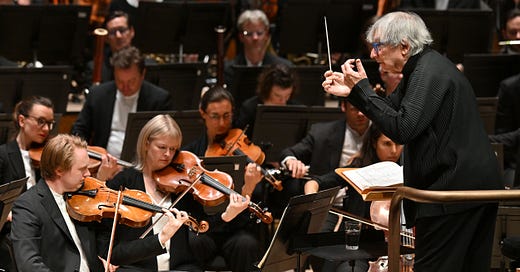Spiritual Surrender Rhapsodises Death: Michael Tilson Thomas’s Mahlerian Landmark with the London Symphony Orchestra
Escorting listeners to spheres unknown, the masterful conductor redesigned the ‘Resurrection Symphony’ with Alice Coote and Siobhan Stagg at the Barbican
Michael Tilson Thomas at the baton of the LSO. Credit: Mark Allan/Barbican
Pitting idling life against decisive death, Mahler’s Resurrection Symphony presents a pretext metamusical. Amidst its contrasts of pastiches mimicking indulgent Ländler waltzes, mallets hammering eviction notices, indictments of Icarean hubris and lush interludes, it wages war against symphonic norms. Five movements of memento mori mirror life’s amorphous guise. Igniting superhuman knowledge, Symphony No. 2 invites a higher realm first sparsely then sporadically; slow to surrender before ceding to an aether out of reach.
This supernatural vista passes most conductors by: mortality wins out. Catharsis stepped onstage nevertheless at last night’s earthbound Barbican embodiment by Michael Tilson Thomas and the London Symphony Orchestra.
Immersing mercilessly throbbing tremolos into the strings to open first movement ‘Allegro maestoso,’ Tilson Thomas halted their alarm with an abrupt descent into diminuendo. Such a bent was spent on many moments of the work – a humbling hush to usher away fear; urge rebels to retreat before the skyborne hosts at play. Inhibited were violins beside despotic double basses racing to announce death’s advent with frenetic triplets. Sections were subjected to dogmatically celestial tempi and distinct attacks: the tokens of an Apollonian order governing the existential binary.
Sublimely they were dashed away. Sashaying into hearing, halcyon arrays of violins limned days made wistful by a silent past: the last resorts to solace for the dying man. In Mahler’s programme notes – later retracted by the giant – the composer vividly described a hero in contention with both life and death; demanding answers from the two denied.
Thudding double basses soon returned with their bravado. After spiteful plights by perfectly extended omens courtesy of clarinets and oboes, playful flutes approved an interlude of peace; appeasing harps embodied bliss in their continuous glissandi; earthly goodness was restored. Yet a restraining rein prevailed on lower strings: a rigid rhythm of refined finality. Absenting abandon banished double basses’ fierce col legno strokes to military regularity – but this was Tilson Thomas’s characterisation of lethality: a rule-abiding general come to summon mankind out of wakefulness.
He's no free spirit, as the constant markings in the score of ‘immer noch zurückhalten’ – ‘keep holding back’ – suggest.
Spiralling steadily out of control as per Mahler’s instructions, strings scampered after cymbals’ brazen blasts – fleeing timpani drumrolls and brass suavely tasked with the role of the death knell.
Sardonically innocuous displays of Ländler waltzes followed in the second movement – radiating dainty warmth in keeping with their craftsman’s humour. Moving these (deceptively?) ingratiating bars through fidgety motifs of neverending triplets, Tilson Thomas masterfully captured Mahler’s paradox of lifespan vs. unavoidable banality, sustaining ritualistic rhythms in the dances. Cellos loosened straitlaced trills and strings tinged pizzicato with a flavour saccharine.
Flouting mortal flaws with taunts by English horn in the third movement, ‘In ruhig fließender Bewegung’ (‘In a calm, flowing movement’), Tilson Thomas’s ensemble brandished parody with the addition of a smacking rute and brusque percussive belches of excess. This condemnation of life’s meaningless excursions met with staggered obstacles: immaculately measured tremolos and stayed crescendi; harsh reminders of the time-staller to come.
A sombre resignation was the next stage of this soulful escapade. Angst steered mezzo-soprano Alice Coote into an alto register demurely vulnerable; enrobing her description of the ‘Röschen rot’ (‘little red rose’) that opens fourth movement ‘Urlicht’ with tangible fragility. Higher notes emerged in peril – especially the A flat around ‘Pein’ (pain); a noticeable breath cleft ‘Himmel’ (‘sky’). Nevertheless the vocalist brought mystery with her enhancing stress on ‘breiten weg’ (‘broad path’), imbuing heaven’s portrait with solemnity.
In lissome layers harps extended their glissandi after raptly charging tremolos and rousing brass and woodwind broke the final movement open. Transfixing arcs on violin insisted on another overdue reminder from the loitering grim reaper; protesting strings pristinely rushed to hide themselves from sight. Eventually double basses plodded into death while offstage trumpets squabbled in pronounced antiphony: the psychic schism of one’s final hours.
Exuding soothing sermons of acceptance, the choir sang ‘Was entstanden ist, das muss vergehen! Was vergangen, auferstehen!’ (‘What has come into being must perish! What perished must rise again!’) with an entrancing invitation to deliverance. Serenity embayed the double basses; shrinking their omnipotence to slender strokes. Soprano Siobhan Stagg sustained an incandescent hold on ‘Wird der dich rief dir geben’ (‘[Immortal life] will be given by Him who called you’). Strings succumbed to a soft hum accompanying wayfarers on their next journey.
Ever death-defying, Mahler’s Resurrection Symphony emerged miraculously scripted in this concert at the hands of Michael Tilson Thomas: a transcendent rendering attesting to the immortality of musical performance, art and man.




